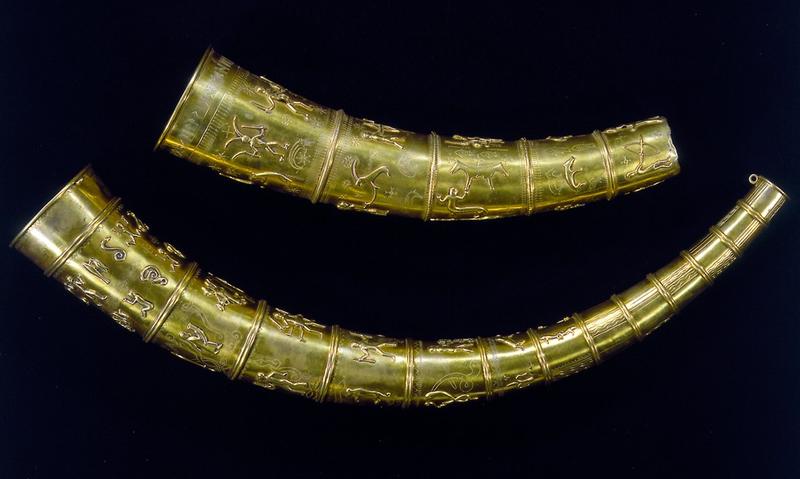Golden Horns of Gallehus: Found, Stolen, and Forever Gone
If you are a Viking enthusiast and you learn of the Golden Horns of Gallehus, I bet you exclaimed: "What a pity!" when you read the whole story about these beautiful horns. The story began in 1693 in Gallehus, southern Jutland, Denmark.
The first horn
On the 20th July 1693, a poor Danish woman Kirsten Svendsdatter happened to stumble upon a "tree trunk" when she was walking on her daily way to the market. At first, she thought it was a tree root stemming from the ground. But at a closer look, she saw something sparkling.
Kirsten pulled the "root" from the ground and started to remove the dirt around it. Then what came into her eyes was a beautiful golden horn which would cost much money than what she could make in her lifetime.
She brought the horn back home and secretly wrote a letter to the Christian IV who was the King at that time. During that time, the King had the rights to own all the gold that was found in Denmark. This law is still in effect in this day and age but instead of belonging to the Royal family, the gold had to be handed to the government who would pay an amount of money for the treasure.
Poor Kirsten only got a new skirt from Christian IV and I truly wish that she had been offered the most beautiful skirt of her time for her discovery.

Drawing of Kirsten with her extraordinary discovery
This horn found by Kirsten was 75.8 centimeters (~30'') and weighed approximately 3.1 kilos (6.8 lbs). It was made of gold alloy mixed with silver. The outside layer of the horn was decorated with rings made from pure gold. There were seven rings in total and each ring was decorated with humans, animals, and trees.
The second horn
Almost 100 years later on 21st April 1739, just about 20 meters away from the first horn was found, there appeared another horn. This time was found by a man Erik Lassen. He was digging on the field for clay when he happened to discover the second horn.

Immediately, he travelled to Schackenborg Castle to hand the horn to his Earl. In return, he was awarded with 200 rigsdalers. It was a huge amount of money back to the 18th century in Denmark. A Danish man must have worked about 800 - 900 days to earn 200 rigsdalers.
This horn was shorter than the first one, about 71 centimeters (~28'') but it was a little bit wider than the first one and weighed a little bit heavier. The horn was made from similar materials with the one found by Kirsten.

The discovery of the second golden horn in the 18th century
The second horn was divided into five rings and there were decorations on each ring just like the first one.
But we will never see the original horns again...
What a pity that our generation and future ones will never be able to observe the majesty of the horns again.
In 4th May 1802, the two golden horns of Gellehus were stolen from Royal chamber of art in Copenhagen. This news hit the headline and the authority claimed that would award those who had the information of the theft, about 1,000 rigsdalers.

What left for us are the replicas of the golden horns
The theft then turned out to be a poor goldsmith and watchmaker, Niels Heidenreich. He used a forged key and sneaked into the storage house. After bringing the horns home, he melted it down to make useless coins.
He tried to sell the jewelry and coins made from the horns. But because he had mixed the coins with brass, he was finally arrested leading to his confession of stealing the golden horns. The man was sentenced for 37 years behind the bars.




